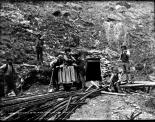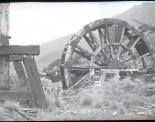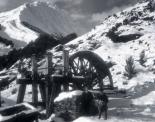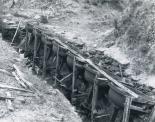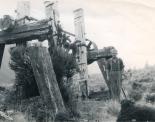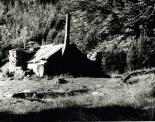THE INVINCIBLE Gallery
INVINCIBLE MINE AND POST OFFICE
Miners in the past seemed to have had a way with words. How else can we explain the Bonnie Jean (named for the lovely Jenny Aitken), the Boozer, and the Marvel Comic hero-sounding Invincible? This month we’re going to pay homage to the Invincible Mine and share the story of its dramatic rise and fall in the heady days of the 1880s.
Today, if you take a drive up the Rees Valley Road you’ll come upon a track that will lead you up to the old site. Back in 1879, two young shepherds, W. Rainey and W.T. Campbell came upon a quartz reef while they were mustering up the hillside. Finding a quartz reef suggested there just might be gold in them thar hills, and it wasn’t long before James Evan and Thomas Hope staked out a claim and called it The Invincible. By September of 1880 the Invincible Quartz Mining Company had been formed and all of the smaller local claims (with names like The Little Wonder, Guiding Star, and Right Bower) all amalgamated under the single claim.
It is hard to imagine how difficult it would have been to bring mining equipment up to the Invincible site, especially as there was no road. Though Council had promised a road up the valley, the newspapers reported complaints that Glenorchy was “out of sight, out of mind” to the council who wasn’t delivering on its promises. By May 1881, George Cockburn had hauled up fourteen tons of equipment which included a stamping battery, a 24 foot over-shot waterwheel, 700 feet of water race to drive the wheel and a blanket table to collect the quartz after crushing. Cockburn had used half a cwt of dynamite to blast a road up the valley, the same road we use today.
The first few years were exciting times at the Invincible. In the first year their quartz crushing yielded 335 ounces. By 1883 they were up to 2,045 ounces and in their best year, 1884, they came away with 2,226 ounces of gold. At its height of activity there were sixteen men working below ground, six working above, and a few others who brought in supplies and materials. In time, the mine attracted the attention of a Professor Black from the Otago University Mining School who worked out how to collect 108 ounces of gold from 11 ½ tons of pyrites. His group, the Otago Pyrites Saving Company, constructed a 2,200 foot flume down to the Cornish Buddle that’s still there today. The Buddle (28’ in diameter) was designed to separate pyrite from sand. There were seven men working full time.
In 1886, a new manager came along who constructed 7 berdans (large crushing bowls) and though they had many men working, they only came away with 1,100 ounces of gold. The next few years proved rough ones and much was blamed on the new manager who might not have had the skill or experience to know what to do.
The mine created both other industries and a whole settlement of its own. Timber to build the mine was brought in from McBride’s sawmill across in Kinloch, and as many as fifty people were living around the mine. The centre was McDougall’s store and post office. (The post office is our photo of the month…a photo just unearthed by Geoffrey Thomson this week!). Post leaving the Invincible Post Office could be in Invercargill in only 36 hours, a service unlikely to be achieved today.
The Invincible saw its zenith in 1884 and by the end of the decade it was in liquidation. Though the Rees Valley Quartz Mining Company bought it for 28,000 pounds in 1890, putting in a 300 foot tunnel in 1896 with ten men working but the venture failed, too, with their license cancelled in 1897. In 1902, a Dunedin syndicate formed the Invincible Goldfields Company but they failed as did a 1913 syndicate from Melbourne. Just before the depression, Thornton and Fred Fitt had some success, but only for a little while.
Though the mine had a fabulous name and yielded about 9,000 ounces in the end, it quietly fell into ruin throughout the 20th century. Much of its machinery can be found in the Lakes District Museum and we can appreciate it in photos like the ones here. This month’s photos include the old post office/shop; Barbara Heffernan in the snow; the waterwheel in 1939; the berdans; the mine buildings; stamp battery and a group of miners.
Save the Date: Come join us on July 8 for a night of Vintage Video…old photos and films, voices from the past, and a night of stories from Glenorchy’s past. More info coming soon but make sure to plan to join us in the hall at 7pm!


